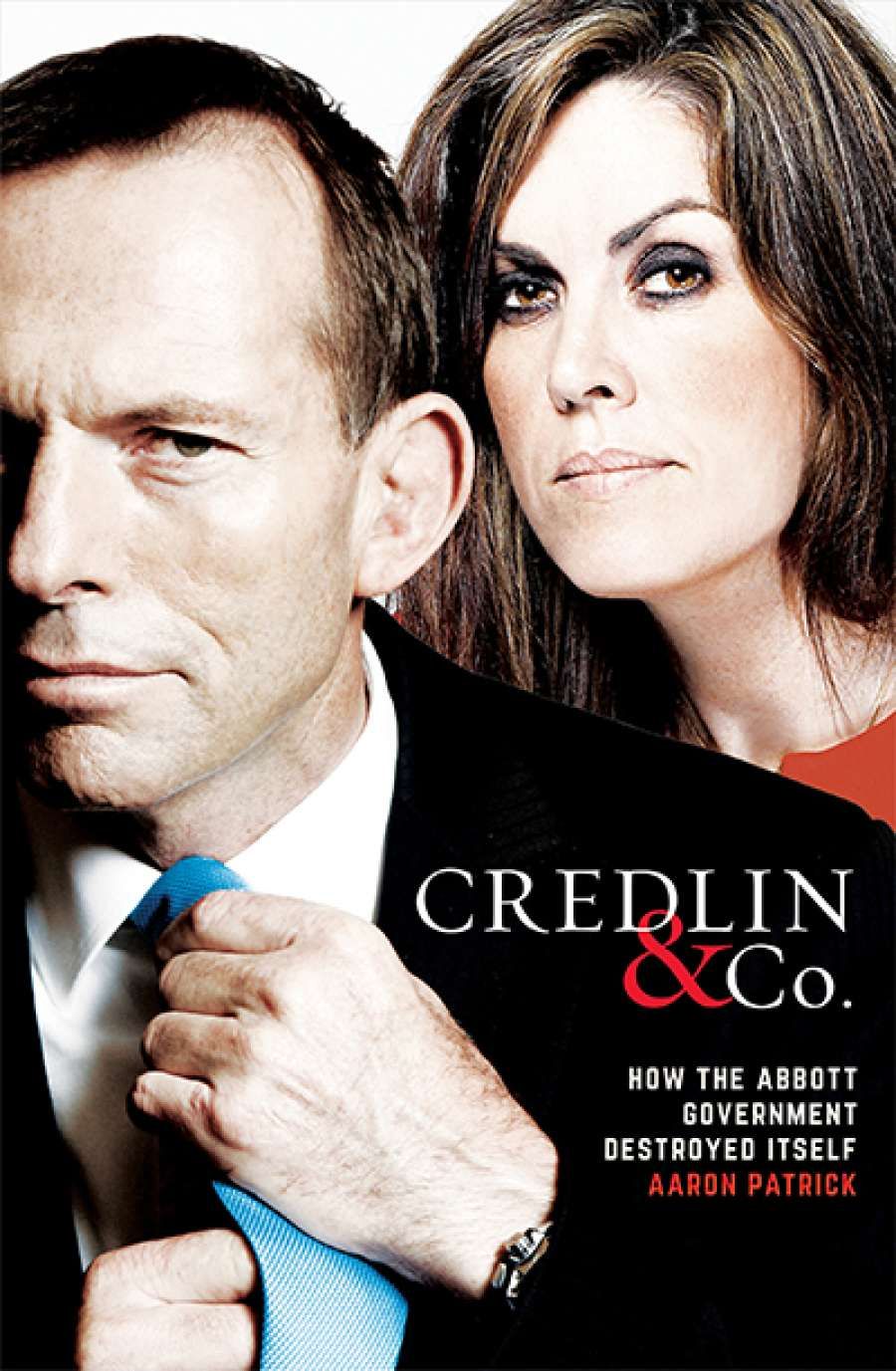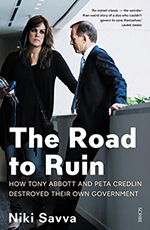
- Free Article: No
- Contents Category: Politics
- Custom Article Title: Lucas Grainger-Brown reviews 'Credlin & Co.' by Aaron Patrick and 'The Road to Ruin' by Niki Savva
- Custom Highlight Text:
In August 2014, then Prime Minister Tony Abbott gave a short speech disagreeing with the contention put forward in Triumph and Demise: The Broken Promise ...
- Book 1 Title: Credlin & Co
- Book 1 Subtitle: How the Abbott government destroyed itself
- Book 1 Biblio: Black Inc., $29.99 pb, 312 pp, 9781863958097
- Book 2 Title: The Road to Ruin
- Book 2 Subtitle: How Tony Abbott and Peta Credlin destroyed their own government
- Book 2 Biblio: Scribe, $32.99 pb, 326 pp, 9781925321401
- Book 2 Cover Small (400 x 600):

Both accounts retrace an almost identical, equally horrifying, chronology. Signposts along the ruinous road include the Thatcherite first budget; an almost all-male ministry; a darkly hilarious Knightmare; diplomatic shirtfronts; escalating flag counts on the home front; the Team Australia branding disaster; Bronwyn Bishop's return to earth; and Cabinet leaking like an illegally towed 'on water matter'. Reliving the touchstones of the Abbott government is enough to crush the spirit. Thankfully, Savva and Patrick traverse the wasteland assuredly and productively, filling in the interesting blanks of well-known disasters.
Savva remains true to the autobiographical style of her first work, So Greek: The confessions of a conservative lefty (2010), which charted her time as press secretary to Peter Costello and adviser to John Howard. Road to Ruin is polemical and frustrating, yet undeniably compelling. Savva has penned an insider's account for political junkies. A granular recall of the Abbott era is assumed and often needed where the retelling becomes one-eyed. For a lefty, Savva seems to lead with her right. She is a connoisseur of – and, through her weekly column in The Australian, still an active force among – the public bloodsports and storied backrooms of politics. This immersion and passion shows through. The Road to Ruin is a Joe-Cinque's-Consolation-style contribution to political journalism.
Patrick is more of a policy wonk. The adjective 'fascinating' litters his text, and the enthusiasm is contagious. Credlin & Co is Patrick's second muckraking of government failure in three years; Downfall: How the Labor government ripped itself apart (2013) was his first, and he is now a practised hand. His is a quick, judicious, and balanced read that synthesises an accessible account whilst carefully introducing all players and most factors. For a one-time member of Young Labor, Patrick's voice is convincingly non-partisan. Nonetheless, he pulls no punches: one of the first things we learn about Joe Hockey is 'he tried diets all his life. All had failed.'
These two books are examples of what is colloquially known as a 'cut job': codifications of publicly available media records, contextualised with follow-up interviews. But the phrase 'cut job' applies in another sense. Each text strips its recently deposed subjects to the marrow. Abbott and Credlin's divide-and-conquer strategy conjured a constellation of enemies upon whose testimony the authors rely for depth and background. Unsurprisingly, these testimonies are incriminating. Accepting the insider's version of events places Savva and Patrick at odds with Marx, modernity's great historiographer, whose full aphorism runs thus: history repeats itself, first as tragedy, second as farce. Following Gillard's original sin and Rudd's counter-coup, it seems improbable that history will judge Abbott's ousting as his and Credlin's tragedy, and not the descent of Turnbull, his colleagues – and, indeed, our two-party political system – into farce.
 Aaron Patrick, author of Credlin & Co: How the Abbott government destroyed itself.Patrick's five-part book conforms to the five plot stages of the ideal tragedy as laid out by Aristotle in Poetics. Deploying this classical formula suggests that Abbott and Credlin are, in the tradition of the Greek dramatists, people of great capacity whose poignant undoing shows a universal truth. The narrative builds towards such a revelation, but never delivers. Instead, Patrick falls back on the trope that Abbott is a bad actor who must cling to Credlin's script. Abbott, an ostensible 'foreigner', is dependent on her providing him with a cogent lifeline back to middle Australia. He is simply not what Patrick, the print editor of Australian Financial Review, most desires: a political centrist focused on continuing the Hawke–Keating economic project. Politics does not well suit a morality tale.
Aaron Patrick, author of Credlin & Co: How the Abbott government destroyed itself.Patrick's five-part book conforms to the five plot stages of the ideal tragedy as laid out by Aristotle in Poetics. Deploying this classical formula suggests that Abbott and Credlin are, in the tradition of the Greek dramatists, people of great capacity whose poignant undoing shows a universal truth. The narrative builds towards such a revelation, but never delivers. Instead, Patrick falls back on the trope that Abbott is a bad actor who must cling to Credlin's script. Abbott, an ostensible 'foreigner', is dependent on her providing him with a cogent lifeline back to middle Australia. He is simply not what Patrick, the print editor of Australian Financial Review, most desires: a political centrist focused on continuing the Hawke–Keating economic project. Politics does not well suit a morality tale.
Savva's contention likewise relies on misplaced tragic archetypes. Hers is an almost Shakespearian take. We are invited to see the fateful pairing of Macbeth: Credlin plays an ear-whispering Lady to Abbott's increasingly delusional Thane. The first two chapters solely – and sensationally – expose Credlin's villainy. The body count quickly mounts; Savva has amassed a warehouse of victim's statements. Dozens of politicians, donors, and senior staffers have put their names to candid tales of Credlin's unpredictability, poor management skills, and epic grudge matches. Some stories are particularly egregious. Credlin read staffers' phone records; undermined one experienced operator's mental health; used the press indiscriminately against elected members of Parliament. The 2014 Budget and the 2016 Defence White Paper were both compromised by her backroom authoritarianism.
 Niki Savva, author of The Road to Ruin: How Tony Abbott and Peta Credlin destroyed their own government.Savva's fixation on Credlin springs from a desire to understand where the 'Tony Abbott many of us knew – the larrikin, unkempt, undisciplined' went when he became PM. Her ambivalence toward a leader she once respected is the driving tension in The Road to Ruin. According to Savva's own retelling, this respect was misplaced. At one time or another Abbott lied to, or about, almost every member of his government. For a man professing honour and tradition, he resorted time and again to backstabbing. Targets of his assassin's knife include Peter Reith, Arthur Sinodinos, Philip Ruddock, Tony Smith, and Joe Hockey.
Niki Savva, author of The Road to Ruin: How Tony Abbott and Peta Credlin destroyed their own government.Savva's fixation on Credlin springs from a desire to understand where the 'Tony Abbott many of us knew – the larrikin, unkempt, undisciplined' went when he became PM. Her ambivalence toward a leader she once respected is the driving tension in The Road to Ruin. According to Savva's own retelling, this respect was misplaced. At one time or another Abbott lied to, or about, almost every member of his government. For a man professing honour and tradition, he resorted time and again to backstabbing. Targets of his assassin's knife include Peter Reith, Arthur Sinodinos, Philip Ruddock, Tony Smith, and Joe Hockey.
Many commentators – from David Marr to Robert Manne to Savva herself, in her first book – have concerned themselves, to no avail, with the political and spiritual mysteries of Tony Abbott. Louis Nowra, writing in The Monthly in 2010, put it best: Abbott's psychology is 'a coil of such saturnine weirdness that no one, not even his closest friends, would want to unravel it'. This is not to be unkind; similar things could be said of most powerful individuals. Political diagnosis via retrospective psychoanalysis is an entertaining black hole from which little insight can derive.
Certainly, Savva and Patrick glean little insight from Australia's third political coup in six years. Framing this story as a two-person tragedy makes for a riveting read, but it neatly avoids all the broader implications of the entrenched new normal. Savva ridicules as 'tosh' Paul Kelly's idea that our poll-driven political system has decoupled from the needs of the nation. Rather, the calibre of the people are to blame: 'Between 2007 and 2013, the "system" threw up three deeply flawed and deficient individuals who became prime minister, then the system rose up to eject them.' Patrick believes, contentiously, that Turnbull is a 'man who reflects Australia' and this somehow legitimises his rerun of Gillard's brutality. 'His elevation', Patrick writes, is a 'sign that, over time, a democracy delivers leaders representative of broader society'.
 The newly sworn in Abbott Government in 2013 (source: Department of Foreign Affairs and Trade, Wikimedia Commons)
The newly sworn in Abbott Government in 2013 (source: Department of Foreign Affairs and Trade, Wikimedia Commons)
Political history devastatingly repeated is painted as a mere cautionary tale for office managers to delegate and politicians to resonate with the mainstream. These conclusions are disappointing, and undermine two fine texts in their closing stages. Buttressing the status quo rings false given that both authors are simultaneously writing history and legitimating the present. In these accounts, beyond Credlin and Abbott, censure falls only on Hockey and Brian Loughnane, the former federal director of the Liberal Party. All four are former members of the current regime. In the words of Walter Benjamin, 'history is written by the victors'.
Undoubtedly, the pathos attached to Abbott and Credlin suits the tragic form well. But their tenure coincided with litmus tests for human frailty much larger than those explored by Savva and Patrick. Deepening globalism, accelerating technological change, mass digitisation of communication and culture, dislocations of family, faith, nation-state, and carbon-intensive economic models are several. The Abbott government did not pragmatically engage with any of these issues. If it had done so, the government's power plays would arguably have been mere footnotes to electoral success.
Ours is an era characterised by a relentless pace of change. Politics will inevitably have to adapt as the society, economy, culture, and environment change. These two books confirm that this consciousness is yet to fully permeate Australia's political and journalistic class such that a real agenda for the twenty-first century might replace the current cycle of suffering and catharsis.


Comments powered by CComment